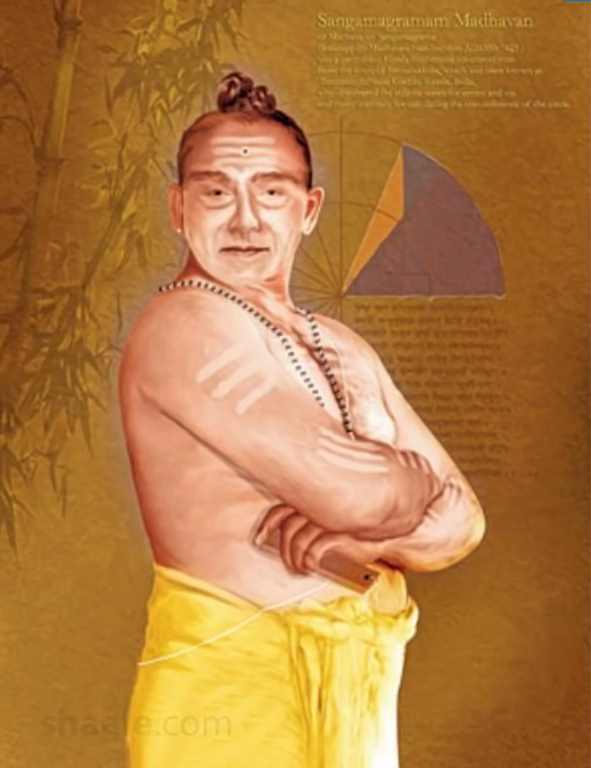Madhava of Sangamgram

Madhava of Sangamgram (c. 1340 – c. 1425) was a famous Kerala mathematician-astronomer, who hailed from a town called Irnalakkuta near Cochin district in the state of Kerala, India. He is considered the founder of the Kerala Mathematical Sampradaya (Kerala School of Astronomy and Mathematics). He was the first to develop an approximation with multiple infinite ranges, which has been called “a decisive step beyond the infinite method of ancient mathematics in taking the limit-transformation to infinity”. His discovery led those ways. Madhavan made pioneering contributions to the study of infinite series, calculus, trigonometry, geometry and algebra. He made some important advances in infinite series including finding the expansions for trigonometric functions. He was one of the greatest mathematicians-astronomers of the medieval period.
Madhav went on to link the idea of an infinite series with geometry and trigonometry. He realized that on successively adding and subtracting different odd number fractions to infinity, he could home in on an exact formula for π (this was two centuries before Leibniz was to come to the same conclusion in Europe). Through his application of this series, Madhava obtained a value for π correct to an astonishing 13 decimal places.
Madhava discovered the equivalent series of the expansion of sin x, cos x, and arctan x around 1400, which is over two hundred years before they were rediscovered in Europe. Details appear in a number of works written by his followers such as Mahajyanayana prakara which means Method of computing the great sines.
Jyeshthadeva wrote Yukti-bhasha in Malayalam. which is the regional language of Kerala
Jyesthadeva describes Madhava’s series as follows:-
The first term is the product of the given sine and radius of the desired arc divided by the cosine of the arc. The succeeding terms are obtained by a process of iteration when the first term is repeatedly multiplied by the square of the sine and divided by the square of the cosine. All the terms are then divided by the odd numbers 1, 3, 5, .... The arc is obtained by adding and subtracting respectively the terms of odd rank and those of even rank. It is laid down that the sine of the arc or that of its complement whichever is the smaller should be taken here as the given sine. Otherwise the terms obtained by this above iteration will not tend to the vanishing magnitude.This is a notable passage describing Madhava’s series, but remember that this passage from Jyeshtadeva was also written 100 years before this series expansion was rediscovered by James Gregory. Perhaps we should write down in modern symbols exactly what the series is that Madhava has found. The first thing to note is that the Indian meaning for sine of θ would be written in our notation as r \,sin \theta and the Indian cosine of would be r \,cos \theta in our notation, where r is the radius. Thus the series is
r \theta=r\frac{r \,sin \theta}{r \,cos\theta}- r \frac{r \,(sin \theta)^3}{3r \,(cos\theta)^3}+r\frac{r \,(sin \theta)^5}{5r \,(cos\theta)^5}-r\frac{r \,(sin \theta)^7}{7r \,(cos\theta)^7}+...putting\; tan =\frac{sin}{cos}\;and\; cancelling\; r\;\; gives\theta=tan\theta-\frac{1}{3}tan^3\theta+\frac{1}{5}tan^5\theta-...which is equivalent to Gregory’s series
tan^{-1}\theta=\theta-\frac{1}{3}\theta^3+\frac{1}{5}\theta^5-...Now\; Madhava \;put\; q = \frac{\pi}{4} \; into\; his\; series\; to\; obtain\frac{ \pi}{4} = 1-\frac{1}{3}+ \frac{1}{5}-\frac{1}{7}+...and \;he\; also\; put\; \theta = \frac{\pi}{6}\; into\; his\; series\; to\; obtain\;\pi=\sqrt{12} \left (1- \frac{1}{3\times3}+\frac{1}{5 \times3^2}- \frac{1}{7 \times3^2}+... \right )We \; know \;that \;Madhava \;obtained \;an \; approximation \;for \;\pi\; correct\; to \;11 \;decimal \;places \\ \;when \;he \;gave\;\pi = 3.14159265359
Madhava of Sangamgram (c. 1340 – c. 1425) was the first to develop an approximation with multiple infinite ranges, which has been called “a decisive step beyond the infinite method of ancient mathematics in taking the limit-transformation to infinity”. His discovery led those ways. Madhavan made pioneering contributions to the study of infinite series, calculus, trigonometry, geometry and algebra. He made some important advances in infinite series including finding the expansions for trigonometric functions.
source : Madhava of Sangamagrama
source : Wikipedia
